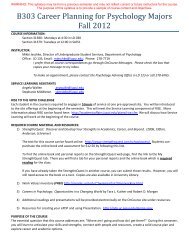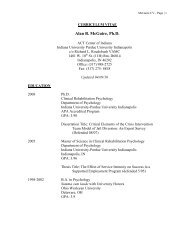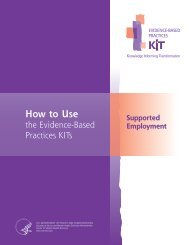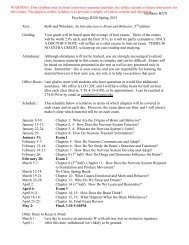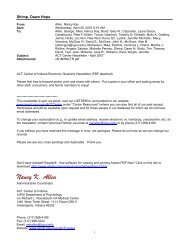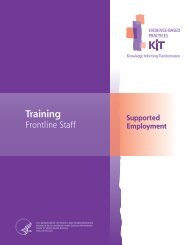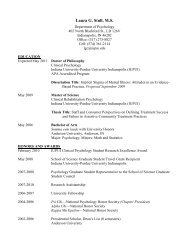Cognitive and clinical predictors of success in vocational ...
Cognitive and clinical predictors of success in vocational ...
Cognitive and clinical predictors of success in vocational ...
You also want an ePaper? Increase the reach of your titles
YUMPU automatically turns print PDFs into web optimized ePapers that Google loves.
Schizophrenia Research 70 (2004) 331–342<br />
www.elsevier.com/locate/schres<br />
<strong>Cognitive</strong> <strong>and</strong> <strong>cl<strong>in</strong>ical</strong> <strong>predictors</strong> <strong>of</strong> <strong>success</strong> <strong>in</strong> <strong>vocational</strong><br />
rehabilitation <strong>in</strong> schizophrenia<br />
Jovier D. Evans a, *, Gary R. Bond a , Piper S. Meyer a,b , Hea Won Kim a,f ,<br />
Paul H. Lysaker c,d , P. Joseph Gibson e , S<strong>and</strong>ra Tunis e<br />
a Department <strong>of</strong> Psychology, Indiana University-Purdue University Indianapolis (IUPUI), LD 124, 402 N. Blackford Street, Indianapolis,<br />
IN 46202-3275, USA<br />
b Cecil G. Sheps Center for Health Services Research, University <strong>of</strong> North Carol<strong>in</strong>a at Chapel Hill, Chapel Hill, NC, USA<br />
c Roudebush VA Medical Center, Indianapolis, IN, USA<br />
d Indiana University School <strong>of</strong> Medic<strong>in</strong>e, USA<br />
e Eli Lilly & Company, USA<br />
f School <strong>of</strong> Social Work, Indiana University, USA<br />
Received 28 May 2003; received <strong>in</strong> revised form 5 January 2004; accepted 12 January 2004<br />
Available onl<strong>in</strong>e 19 March 2004<br />
Abstract<br />
<strong>Cognitive</strong> impairments <strong>in</strong> schizophrenia appear to be associated with social problem solv<strong>in</strong>g, social <strong>and</strong> <strong>vocational</strong><br />
function<strong>in</strong>g, <strong>and</strong> psychosocial skill acquisition. The present study exam<strong>in</strong>ed the relationship <strong>of</strong> cognitive function<strong>in</strong>g, as well as<br />
<strong>cl<strong>in</strong>ical</strong> symptoms, to <strong>vocational</strong> outcomes among <strong>in</strong>dividuals with schizophrenia. One hundred <strong>and</strong> twelve participants with<br />
DSM-IV schizophrenia spectrum diagnoses underwent a comprehensive neuropsychiatric evaluation after enroll<strong>in</strong>g <strong>in</strong> one <strong>of</strong><br />
several employment programs. The neuropsychological evaluation exam<strong>in</strong>ed verbal learn<strong>in</strong>g <strong>and</strong> memory, attention, speed <strong>of</strong><br />
<strong>in</strong>formation process<strong>in</strong>g, <strong>and</strong> executive function<strong>in</strong>g. Cl<strong>in</strong>ical symptoms were evaluated with the Positive <strong>and</strong> Negative Syndrome<br />
Scale (PANSS). Vocational outcomes were assessed 4 months after basel<strong>in</strong>e assessment <strong>and</strong> <strong>in</strong>cluded both measures <strong>of</strong><br />
employment outcome (e.g., earn<strong>in</strong>gs) <strong>and</strong> <strong>of</strong> work performance as assessed by the Work Behavior Inventory (WBI). Negative<br />
symptoms, learn<strong>in</strong>g <strong>and</strong> memory performance, process<strong>in</strong>g speed, <strong>and</strong> executive function<strong>in</strong>g were related to hours, weeks, <strong>and</strong><br />
wages earned on the job. Stepwise multiple regression analyses found that among basel<strong>in</strong>e <strong>cl<strong>in</strong>ical</strong> <strong>and</strong> cognitive <strong>predictors</strong>,<br />
only verbal learn<strong>in</strong>g <strong>and</strong> memory <strong>and</strong> cognitive disorganization symptoms were significant <strong>predictors</strong> <strong>of</strong> work behaviors 4<br />
months later. Learn<strong>in</strong>g <strong>and</strong> memory were the only significant <strong>predictors</strong> <strong>of</strong> <strong>in</strong>tegrated employment at 4 months. These results<br />
suggest specific aspects <strong>of</strong> cognition may be modestly predictive <strong>of</strong> <strong>vocational</strong> outcomes.<br />
D 2004 Elsevier B.V. All rights reserved.<br />
Keywords: Schizophrenia; Neuropsychology; Vocational outcomes; Symptoms<br />
1. Introduction<br />
* Correspond<strong>in</strong>g author. Tel.: +1-317-274-2283; fax: +1-317-<br />
274-6756.<br />
E-mail address: jevans2@iupui.edu (J.D. Evans).<br />
<strong>Cognitive</strong> impairments are ga<strong>in</strong><strong>in</strong>g attention for<br />
their possible role <strong>in</strong> the social <strong>and</strong> occupational<br />
deficits that accompany schizophrenia. Recent re-<br />
0920-9964/$ - see front matter D 2004 Elsevier B.V. All rights reserved.<br />
doi:10.1016/j.schres.2004.01.011
332<br />
J.D. Evans et al. / Schizophrenia Research 70 (2004) 331–342<br />
views <strong>of</strong> the literature have suggested these cognitive<br />
impairments as ‘‘rate-limit<strong>in</strong>g’’ factors <strong>in</strong> <strong>success</strong> <strong>in</strong><br />
both social <strong>and</strong> occupational doma<strong>in</strong>s <strong>of</strong> outcome<br />
(Green, 1996; Green et al., 2000). Several l<strong>in</strong>es <strong>of</strong><br />
<strong>in</strong>vestigation <strong>in</strong>to adaptive function <strong>in</strong> schizophrenia<br />
have documented relationships between cognitive<br />
function<strong>in</strong>g <strong>and</strong> performance <strong>of</strong> everyday activities<br />
(Brekke et al., 1997; Green, 1996; Harvey et al.,<br />
1998). Specifically, these studies have noted that executive<br />
function<strong>in</strong>g abilities, verbal memory, <strong>and</strong> vigilance<br />
are related to work performance, social<br />
function<strong>in</strong>g, <strong>and</strong> perform<strong>in</strong>g basic self-care activities.<br />
Several dimensions <strong>of</strong> adaptive function have been<br />
studied <strong>in</strong> relationship to cognitive performance, <strong>in</strong>clud<strong>in</strong>g<br />
work performance <strong>and</strong> occupational goals<br />
(Bell <strong>and</strong> Lysaker, 1995; Lysaker et al., 1995a,b), social<br />
skills performance (Corrigan <strong>and</strong> Green, 1993; Patterson<br />
et al., 1997; Smith et al., 1999), <strong>and</strong> community<br />
outcomes (Brekke et al., 1997; Green et al., 2000).<br />
Most <strong>of</strong> this work has found that cognitive function is<br />
associated with concurrent measures <strong>of</strong> adaptive function<br />
such as work performance; however, relatively few<br />
studies have attempted to exam<strong>in</strong>e the predictive utility<br />
<strong>of</strong> cognitive performance on future <strong>vocational</strong> <strong>success</strong>.<br />
Bellack et al. (1999) found that cognitive function<strong>in</strong>g<br />
was related to competitive employment among a<br />
group <strong>of</strong> psychiatric outpatients. Specifically, process<strong>in</strong>g<br />
speed <strong>and</strong> social judgment were related to good<br />
<strong>vocational</strong> outcomes among a large community sample.<br />
Other studies have also found significant relationships<br />
among work outcomes <strong>and</strong> performance on<br />
neuropsychological tests. Results <strong>of</strong> these studies<br />
have determ<strong>in</strong>ed that aspects <strong>of</strong> adaptive function<strong>in</strong>g<br />
are multi-determ<strong>in</strong>ed <strong>and</strong> as such are necessarily<br />
associated with multiple doma<strong>in</strong>s <strong>of</strong> cognitive ability<br />
(Bryson et al., 1998; Velligan et al., 2000a).<br />
McGurk <strong>and</strong> Meltzer (2000) have exam<strong>in</strong>ed the<br />
relationship <strong>of</strong> both cognitive <strong>and</strong> <strong>cl<strong>in</strong>ical</strong> doma<strong>in</strong>s to<br />
<strong>vocational</strong> outcomes <strong>and</strong> have found that cognitive<br />
function<strong>in</strong>g was associated with employment status.<br />
Specifically, full-time employment was associated<br />
with better performance on measures <strong>of</strong> executive<br />
function<strong>in</strong>g, work<strong>in</strong>g memory, <strong>and</strong> vigilance, compared<br />
to unemployed participants. This study also<br />
found that poor premorbid function (as assessed by<br />
educational level), negative symptoms, <strong>and</strong> cognitive<br />
impairments were significantly related to employment<br />
<strong>success</strong> among people with schizophrenia. Gold et al.<br />
(2002) found that among clients enrolled <strong>in</strong> a <strong>vocational</strong><br />
program who achieved employment, several<br />
different measures <strong>of</strong> cognitive performance were<br />
related to the total number <strong>of</strong> hours <strong>of</strong> employment.<br />
However, cognitive measures did not predict who<br />
would work at all. This study suggests that cognitive<br />
measures are most predictive <strong>of</strong> employment outcomes<br />
among those who are motivated enough to<br />
start a job.<br />
A recent study by McGurk et al. (2003) suggests<br />
that the type <strong>of</strong> <strong>vocational</strong> <strong>in</strong>terventions <strong>and</strong> supports<br />
that are given to clients <strong>in</strong>fluences the relationship<br />
between cognitive impairment <strong>and</strong> work outcomes.<br />
She found that <strong>in</strong>dividuals with cognitive impairments<br />
were capable <strong>of</strong> competitive employment, but that<br />
they required more <strong>in</strong>tervention by the <strong>vocational</strong> staff<br />
than less impaired clients. Therefore, the relationship<br />
between cognitive function <strong>and</strong> measures <strong>of</strong> employment<br />
outcomes (e.g., atta<strong>in</strong>ment <strong>of</strong> a competitive job,<br />
hours worked, <strong>and</strong> job tenure) may be moderated by<br />
the level <strong>of</strong> support <strong>and</strong> other factors, such as employer<br />
accommodation <strong>of</strong> work limitations (McGurk<br />
et al., 2003). Other researchers have concluded that an<br />
effective goal <strong>of</strong> rehabilitation programs might best be<br />
directed toward teach<strong>in</strong>g clients compensatory strategies<br />
for their cognitive deficits rather than try<strong>in</strong>g to<br />
directly remediate these deficits (Velligan et al.,<br />
2000b).<br />
Another type <strong>of</strong> <strong>vocational</strong> measure concerns actual<br />
behavior <strong>in</strong> the work place or observed <strong>in</strong> pre<strong>vocational</strong><br />
work sett<strong>in</strong>gs (e.g., work quality <strong>and</strong><br />
quantity, punctuality, dependability, cooperativeness,<br />
etc.). These measures <strong>of</strong> work performance may be<br />
more proximally related to cognitive status <strong>and</strong> be<br />
measured <strong>in</strong> non-paid work situations, rather than<br />
employment status measures (i.e., gett<strong>in</strong>g a job, hours<br />
worked, job tenure, etc.) that may be more dependent<br />
on external factors outside <strong>of</strong> the <strong>in</strong>dividual. For<br />
example, the benevolence <strong>of</strong> the employer, economic<br />
conditions, <strong>and</strong> work accommodations made at the job<br />
may determ<strong>in</strong>e employment status. Bell <strong>and</strong> Bryson<br />
(2001) found that neuropsychological performance<br />
was significantly associated with work performance<br />
<strong>and</strong> was moderately predictive <strong>of</strong> improvements <strong>in</strong><br />
work performance for participants <strong>in</strong> a 6-month <strong>vocational</strong><br />
rehabilitation program. Specifically, aspects<br />
<strong>of</strong> attention, executive function<strong>in</strong>g, <strong>and</strong> work<strong>in</strong>g<br />
memory were related to improvements <strong>in</strong> performance
J.D. Evans et al. / Schizophrenia Research 70 (2004) 331–342 333<br />
at work. In addition, <strong>cl<strong>in</strong>ical</strong> symptoms were not<br />
predictive <strong>of</strong> these improvements. A recent study by<br />
these researchers found that aspects <strong>of</strong> attention were<br />
related to <strong>in</strong>itial improvements <strong>in</strong> work performance<br />
<strong>and</strong> learn<strong>in</strong>g, <strong>and</strong> memory was related to later<br />
improvements <strong>in</strong> work performance <strong>in</strong> this same 6-<br />
month rehabilitation program (Bryson <strong>and</strong> Bell,<br />
2003). It may be that cognitive measures are more<br />
closely l<strong>in</strong>ked to actual performance on the job than to<br />
employment outcomes. Research has also shown that<br />
supervisor rat<strong>in</strong>gs <strong>of</strong> work performance are related to<br />
employment outcomes (Bond <strong>and</strong> Friedmeyer, 1987;<br />
Bryson et al., 1999).<br />
The purpose <strong>of</strong> the present study is to exam<strong>in</strong>e the<br />
predictive ability <strong>of</strong> basel<strong>in</strong>e neuropsychological performance<br />
<strong>and</strong> <strong>cl<strong>in</strong>ical</strong> symptoms on the <strong>vocational</strong><br />
outcomes <strong>of</strong> a group <strong>of</strong> schizophrenia spectrum clients<br />
enrolled <strong>in</strong> <strong>vocational</strong> services who were participat<strong>in</strong>g<br />
<strong>in</strong> a longitud<strong>in</strong>al study compar<strong>in</strong>g the effects <strong>of</strong><br />
atypical neuroleptic medications with traditional medications.<br />
In addition, we exam<strong>in</strong>ed both employment<br />
outcomes (e.g., hours worked) as well as research staff<br />
rat<strong>in</strong>gs <strong>of</strong> behaviors. We hypothesized that better<br />
<strong>cl<strong>in</strong>ical</strong> symptom control <strong>and</strong> neuropsychological performance<br />
at basel<strong>in</strong>e would be correlated with <strong>and</strong><br />
predictive <strong>of</strong> better <strong>vocational</strong> outcomes 4 months<br />
later.<br />
2. Method<br />
2.1. Subjects<br />
The sample consisted <strong>of</strong> 112 clients recruited as<br />
part <strong>of</strong> a longitud<strong>in</strong>al study to exam<strong>in</strong>e the effects <strong>of</strong><br />
atypical antipsychotic medications on <strong>vocational</strong> rehabilitation<br />
outcomes (Bond et al., <strong>in</strong> press). Inclusion<br />
criteria for the study were as follows: (1) diagnosis <strong>of</strong><br />
schizophrenia spectrum disorders based on DSM-IV<br />
criteria <strong>and</strong> confirmed with the Structured Cl<strong>in</strong>ical<br />
Interview for DSM-IV Axis I Disorders (SCID-I,<br />
Research Version); (2) stable phase <strong>of</strong> disorder as<br />
def<strong>in</strong>ed as hav<strong>in</strong>g no hospitalizations, changes <strong>in</strong><br />
hous<strong>in</strong>g, or changes <strong>in</strong> medication with<strong>in</strong> the past<br />
month; (3) no diagnosis <strong>of</strong> mental retardation, neurological<br />
disorder, or <strong>in</strong>sult to the bra<strong>in</strong> that might affect<br />
their cognitive performance; (4) unemployed at time<br />
<strong>of</strong> program admission; (5) between the ages <strong>of</strong> 18 <strong>and</strong><br />
64; (6) expressed a goal <strong>of</strong> paid employment <strong>and</strong><br />
currently prescribed an antipsychotic medication. On<br />
average, participants were 40 years old, had 12.6<br />
years <strong>of</strong> education (range 6–20), had 7.0 lifetime<br />
psychiatric hospitalizations (S.D. = 10.7), <strong>and</strong> were<br />
ill for a mean <strong>of</strong> 16.5 years (S.D. = 10.4). Most<br />
participants were male (60.7%). The sample consisted<br />
<strong>of</strong> primarily African-American (44.0%) <strong>and</strong> Caucasian<br />
(52.0%) clients.<br />
All clients were prescribed one or more antipsychotic<br />
medications, <strong>in</strong>clud<strong>in</strong>g 14.0% on a traditional<br />
antipsychotic <strong>and</strong> 54.2% were receiv<strong>in</strong>g an atypical<br />
neuroleptic <strong>and</strong> 31.8% receiv<strong>in</strong>g a comb<strong>in</strong>ation. There<br />
were generally no associations between type <strong>of</strong> medication<br />
<strong>and</strong> any <strong>of</strong> the predictor or outcome measures,<br />
so medications were not used as a statistical control <strong>in</strong><br />
the current study.<br />
2.2. Procedures<br />
Study participants were recruited from among<br />
new admissions to day programs at five sites <strong>of</strong><br />
Thresholds <strong>in</strong> Chicago (N = 83), <strong>and</strong> four community<br />
mental health centers <strong>in</strong> Indianapolis (N = 29) from<br />
March 1999 to January 2001. Thresholds is a psychiatric<br />
rehabilitation agency provid<strong>in</strong>g <strong>in</strong>tensive<br />
<strong>vocational</strong> services <strong>in</strong> a stepwise manner, <strong>in</strong>clud<strong>in</strong>g<br />
unpaid work crews, group <strong>and</strong> <strong>in</strong>dividual placements<br />
arranged between Thresholds <strong>and</strong> employers,<br />
enclaves, agency-run bus<strong>in</strong>esses, <strong>and</strong> <strong>in</strong>dependent<br />
jobs. This <strong>vocational</strong> model has been dubbed the<br />
‘‘diversified placement approach’’ (DPA) (Koop et<br />
al., <strong>in</strong> press). The Indiana programs used an <strong>in</strong>dividual<br />
placement model <strong>of</strong> supported employment,<br />
although not strictly adher<strong>in</strong>g to all the pr<strong>in</strong>ciples<br />
<strong>of</strong> evidence-based supported employment (Bond et<br />
al., 2001). A m<strong>in</strong>ority (N = 18) <strong>of</strong> study participants<br />
from Thresholds also received <strong>in</strong>dividual placement<br />
supported employment <strong>in</strong> lieu <strong>of</strong> the stepwise <strong>vocational</strong><br />
services. Because <strong>of</strong> the differences <strong>in</strong> the<br />
program philosophies, the study sample was divided<br />
<strong>in</strong>to two subsamples: DPA (N = 65) <strong>and</strong> supported<br />
employment (N = 47) for some analyses.<br />
Clients giv<strong>in</strong>g <strong>in</strong>formed consent were enrolled <strong>in</strong><br />
the study with<strong>in</strong> 120 days <strong>of</strong> admission to Thresholds<br />
or to the Indianapolis programs. Diagnosis was confirmed<br />
us<strong>in</strong>g either the Structured Cl<strong>in</strong>ical Interview<br />
for DSM-IV (SCID-I) (First et al., 1995) or the
334<br />
J.D. Evans et al. / Schizophrenia Research 70 (2004) 331–342<br />
computerized version <strong>of</strong> the Composite International<br />
Diagnostic Interview (CIDI-A) (World Health Organization,<br />
1997a,b). Participants then completed a<br />
comprehensive evaluation that <strong>in</strong>cluded an exam<strong>in</strong>ation<br />
<strong>of</strong> <strong>cl<strong>in</strong>ical</strong> symptoms, neuropsychological performance,<br />
side effect rat<strong>in</strong>g scales, <strong>and</strong> rat<strong>in</strong>gs <strong>of</strong><br />
<strong>vocational</strong> performance. For the current study, client<br />
<strong>vocational</strong> outcomes were exam<strong>in</strong>ed 4 months after<br />
the <strong>in</strong>itial basel<strong>in</strong>e assessments. Interviewers complet<strong>in</strong>g<br />
the diagnostic assessments, <strong>cl<strong>in</strong>ical</strong> rat<strong>in</strong>gs, <strong>and</strong><br />
neuropsychological assessments were tra<strong>in</strong>ed <strong>and</strong> supervised<br />
by licensed <strong>cl<strong>in</strong>ical</strong> psychologists (JDE <strong>and</strong><br />
PHL) familiar with the <strong>in</strong>struments.<br />
2.3. Measures<br />
Cl<strong>in</strong>ical rat<strong>in</strong>gs <strong>of</strong> symptoms: The Positive <strong>and</strong><br />
Negative Syndrome Scale (PANSS; Kay et al.,<br />
1987) is a 30-item rat<strong>in</strong>g scale completed by tra<strong>in</strong>ed<br />
research staff. Scores for positive, negative, cognitive<br />
disorganization, emotional discomfort, <strong>and</strong> hostility/<br />
excitement symptoms were derived from factor-derived<br />
scor<strong>in</strong>g published by Bell et al. (1994). Internal<br />
consistency rat<strong>in</strong>gs ranged from a = 0.40 for hostility<br />
symptoms to 0.73 for negative symptoms. The<br />
PANSS total score a = 0.79.<br />
Neuropsychological evaluation: All participants<br />
completed a brief neuropsychological evaluation.<br />
The follow<strong>in</strong>g is a list<strong>in</strong>g <strong>of</strong> neuropsychological<br />
measures grouped by the cognitive doma<strong>in</strong> that each<br />
is <strong>in</strong>tended to measure.<br />
Learn<strong>in</strong>g: California Verbal Learn<strong>in</strong>g Test (CVLT;<br />
Delis et al., 1987; Norman et al., 2000) Monday total<br />
trials 1–5.<br />
Secondary verbal memory: CVLT short-delay free<br />
recall <strong>and</strong> long-delay free recall; percent retention<br />
((long-delay free recall raw score/Monday trial<br />
5 raw score) 100).<br />
Executive function<strong>in</strong>g: Wiscons<strong>in</strong> Card Sort<strong>in</strong>g<br />
Test—perseverative responses, <strong>and</strong> categories correct<br />
(WCST; Heaton et al., 1993), <strong>and</strong> Part B <strong>of</strong> the<br />
Trailmak<strong>in</strong>g Test (Reitan <strong>and</strong> Wolfson, 1993).<br />
Short-term memory: WAIS-III Digit Span subtest<br />
(Wechsler, 1997).<br />
Speed <strong>of</strong> <strong>in</strong>formation process<strong>in</strong>g/psychomotor<br />
speed: WAIS-III Digit Symbol, WAIS-III Symbol<br />
Search subtests (Wechsler, 1997), <strong>and</strong> Part A <strong>of</strong> the<br />
Trailmak<strong>in</strong>g Test (Reitan <strong>and</strong> Wolfson, 1993).<br />
Raw scores <strong>of</strong> the neuropsychological tests were<br />
converted <strong>in</strong>to age-corrected scaled scores with a<br />
mean <strong>of</strong> 10 <strong>and</strong> a st<strong>and</strong>ard deviation <strong>of</strong> 3 (WAIS-III<br />
scores) or demographically corrected T-scores with a<br />
mean <strong>of</strong> 50 <strong>and</strong> a st<strong>and</strong>ard deviation <strong>of</strong> 10 (CVLT,<br />
WCST, <strong>and</strong> Trailmak<strong>in</strong>g test) scores (Heaton et al.,<br />
1993; Norman et al., 2000).<br />
Work performance: The Work Behavior Inventory<br />
(WBI; Bryson et al., 1997) is a st<strong>and</strong>ardized work<br />
performance assessment <strong>in</strong>strument specifically<br />
designed for people with severe mental illness. The<br />
<strong>in</strong>strument is a 36-item <strong>in</strong>ventory with five subscales<br />
<strong>and</strong> one global item: Cooperativeness, Work habits,<br />
Work quality, Social skills, <strong>and</strong> Personal presentation.<br />
Each scale comprises 7 items <strong>in</strong>dividually assessed on<br />
a 5-po<strong>in</strong>t scale where ‘‘1’’ represents ‘‘consistently<br />
<strong>in</strong>ferior performance’’ <strong>and</strong> ‘‘5’’ represents ‘‘consistently<br />
superior performance.’’ The range for each<br />
subscale score ranges from 7 to 35. A total score is<br />
calculated as the sum <strong>of</strong> the five subscale scores<br />
(range <strong>of</strong> scores from 7 to 175). Participants <strong>in</strong><br />
appropriate work sett<strong>in</strong>gs were rated by a research<br />
assistant who was tra<strong>in</strong>ed by one <strong>of</strong> the developers <strong>of</strong><br />
this scale (PHL) <strong>and</strong> who followed the author’s<br />
rat<strong>in</strong>gs protocol, mak<strong>in</strong>g direct observation <strong>of</strong> each<br />
client’s behavior at the work site <strong>and</strong> conduct<strong>in</strong>g a<br />
brief <strong>in</strong>terview with their immediate supervisor. WBI<br />
rat<strong>in</strong>gs were completed on only those clients <strong>in</strong><br />
employment <strong>and</strong> pre<strong>vocational</strong> work sett<strong>in</strong>gs <strong>in</strong> which<br />
a research assistant could directly observe work behavior.<br />
This requirement excluded some competitive<br />
jobs. The WBI rat<strong>in</strong>gs were limited to the Thresholds<br />
DPA sample. Mean substitution <strong>of</strong> the WBI scores<br />
were used for miss<strong>in</strong>g data po<strong>in</strong>ts (less than 5% <strong>of</strong> all<br />
responses) <strong>in</strong> the follow<strong>in</strong>g analyses. The WBI had<br />
excellent <strong>in</strong>ternal consistency <strong>in</strong> this sample (WBI<br />
total score a = 0.97; Social skills a = 0.89; Cooperativeness<br />
a = 0.84; Work habits a = 0.93; Work quality<br />
a = 0.96; Personal presentation a = 0.89).<br />
Employment outcome measures: Employment status<br />
at follow-up was coded accord<strong>in</strong>g to a modified<br />
version <strong>of</strong> the Work Placement Scale (Meyer et al.,<br />
2002), consist<strong>in</strong>g <strong>of</strong> a 5-po<strong>in</strong>t gradient: (5) <strong>in</strong>tegrated<br />
employment, which <strong>in</strong>cluded both competitive employment<br />
(a regular community job, with non-disabled<br />
coworkers, pay<strong>in</strong>g m<strong>in</strong>imum wage), <strong>and</strong><br />
<strong>in</strong>dividual placement (agency-contracted community<br />
job), (4) group placement: paid community job at a
J.D. Evans et al. / Schizophrenia Research 70 (2004) 331–342 335<br />
site work<strong>in</strong>g alongside other clients, or an agency-run<br />
bus<strong>in</strong>ess: paid work activity at a bus<strong>in</strong>ess owned <strong>and</strong><br />
run by the rehabilitation agency, (3) sheltered workshop/volunteer<br />
work: paid work activity licensed by<br />
the Department <strong>of</strong> Labor <strong>and</strong> paid on a piece-rate<br />
basis, or unpaid work activity <strong>in</strong> a community employment<br />
site, (2) pre<strong>vocational</strong> tra<strong>in</strong><strong>in</strong>g: unpaid<br />
work tra<strong>in</strong><strong>in</strong>g at the rehabilitation agency, <strong>and</strong> (1)<br />
unemployed: not engaged <strong>in</strong> any <strong>vocational</strong> activity.<br />
Higher scores reflect more <strong>in</strong>dependent employment<br />
activity. Other employment outcome measures <strong>in</strong>cluded<br />
weeks worked, total hours worked, <strong>and</strong> total wages<br />
earned dur<strong>in</strong>g follow-up.<br />
2.4. Statistical methods<br />
Prior to analyses, data were exam<strong>in</strong>ed for normality<br />
<strong>and</strong> homogeneity <strong>of</strong> variance. The WBI outcome<br />
data met parametric assumptions. Violations <strong>of</strong> normality<br />
were noted <strong>in</strong> the PANSS negative, cognitive,<br />
<strong>and</strong> hostility factor scores, total wages earned, total<br />
hours <strong>and</strong> total weeks worked, as well as the WAIS-III<br />
digit symbol subtest scores <strong>in</strong>dicat<strong>in</strong>g moderate positive<br />
skew <strong>in</strong> these variables. However, parametric<br />
tests have been shown to be robust to violations <strong>of</strong><br />
non-normality; therefore, all analyses used parametric<br />
tests on untransformed variables (L<strong>in</strong>ton <strong>and</strong> Gallo,<br />
1975; Tabachnick <strong>and</strong> Fidell, 1996). Nevertheless, to<br />
confirm the robustness <strong>of</strong> the f<strong>in</strong>d<strong>in</strong>gs, we also conducted<br />
appropriate nonparametric tests (e.g., Spearman<br />
rank order correlations) <strong>and</strong> found a similar<br />
pattern <strong>of</strong> results. Employment status was exam<strong>in</strong>ed<br />
through two dichotomies: <strong>in</strong>tegrated employment vs.<br />
other <strong>and</strong> supported employment (SE) vs. diversified<br />
placement (DPA). This was done due to the different<br />
emphasis placed on approaches to job placement <strong>in</strong><br />
the two programs. We exam<strong>in</strong>ed all <strong>of</strong> the predictor<br />
<strong>and</strong> outcome variables by program (supported employment<br />
vs. diversified placement), <strong>and</strong> conducted<br />
all <strong>of</strong> the hypothesized analyses by program type. T-<br />
tests were conducted to compare the basel<strong>in</strong>e <strong>cl<strong>in</strong>ical</strong><br />
<strong>and</strong> cognitive <strong>predictors</strong> <strong>of</strong> those achiev<strong>in</strong>g <strong>in</strong>tegrated<br />
vs. non<strong>in</strong>tegrated employment. In addition, a series <strong>of</strong><br />
multivariate analyses <strong>of</strong> variance (MANOVAs) were<br />
run on the basel<strong>in</strong>e demographic, <strong>cl<strong>in</strong>ical</strong>, <strong>and</strong> neuropsychological<br />
variables to determ<strong>in</strong>e if there were any<br />
differences by program type. In addition, Pearson<br />
product moment correlations between the dependent<br />
variables (objective <strong>vocational</strong> data <strong>and</strong> WBI scores)<br />
<strong>and</strong> the <strong>in</strong>dependent variables (<strong>cl<strong>in</strong>ical</strong> rat<strong>in</strong>g scales<br />
<strong>and</strong> neuropsychological scores) were computed for<br />
the two employment programs. Independent variables<br />
hav<strong>in</strong>g significant or near-significant ( p < 0.2) correlations<br />
were entered <strong>in</strong>to multiple regression analyses<br />
to determ<strong>in</strong>e if the relationships persisted after simultaneous<br />
adjustment (Dales <strong>and</strong> Ury, 1978). An alpha<br />
level <strong>of</strong> 0.05(two-tailed) was used to def<strong>in</strong>e significance<br />
for all analyses.<br />
3. Results<br />
3.1. Basel<strong>in</strong>e characteristics<br />
Among demographic variables, there were no significant<br />
differences between the two groups <strong>in</strong> terms<br />
<strong>of</strong> age, education, or duration <strong>of</strong> illness. Both groups<br />
were about 39 years <strong>of</strong> age, had been ill about 16<br />
years, <strong>and</strong> completed about 12 years <strong>of</strong> school.<br />
There were also no differences <strong>in</strong> <strong>cl<strong>in</strong>ical</strong> or<br />
neuropsychological variables between the Thresholds<br />
program <strong>and</strong> the Indiana programs at basel<strong>in</strong>e<br />
(Table 1). The <strong>cl<strong>in</strong>ical</strong> rat<strong>in</strong>gs <strong>of</strong> illness at basel<strong>in</strong>e<br />
suggest that the participants had mild levels <strong>of</strong><br />
symptoms, as measured by the PANSS. In terms<br />
<strong>of</strong> cognitive performances at basel<strong>in</strong>e, the sample<br />
was mildly to moderately impaired across the various<br />
doma<strong>in</strong>s, (i.e., T-scores < 40). Specific deficits<br />
were seen <strong>in</strong> verbal learn<strong>in</strong>g <strong>and</strong> memory performances<br />
on the CVLT. Speed <strong>of</strong> <strong>in</strong>formation process<strong>in</strong>g<br />
was also moderately impaired compared to<br />
published normative data (Wechsler, 1997). There<br />
was a fair degree <strong>of</strong> variability <strong>in</strong> all symptom <strong>and</strong><br />
cognitive measures with<strong>in</strong> the population, provid<strong>in</strong>g<br />
good potential to detect how basel<strong>in</strong>e differences<br />
might affect outcomes.<br />
3.2. Vocational outcomes<br />
Four months <strong>in</strong>to the study, an exam<strong>in</strong>ation <strong>of</strong> the<br />
WPS found that there were significant differences <strong>in</strong><br />
work placements as a function <strong>of</strong> employment program.<br />
(See Table 2). The overall chi-square was<br />
significant for WPS placement by employment program<br />
(v 2 (4) = 37.4, p < 0.001). This is probably a<br />
consequence <strong>of</strong> the diversified placement approach
336<br />
J.D. Evans et al. / Schizophrenia Research 70 (2004) 331–342<br />
Table 1<br />
Cl<strong>in</strong>ical <strong>and</strong> neuropsychological performance at basel<strong>in</strong>e<br />
SE (N = 47)<br />
(M F S.D.)<br />
(DPA N = 65),<br />
(M F S.D.)<br />
PANSS subscales<br />
Positive 2.3 F 0.9 2.5 + 1.0<br />
Negative 1.6 F 0.5 1.9 + 0.7<br />
<strong>Cognitive</strong> 1.9 F 0.6 1.9 + 0.7<br />
Emotional discomfort 2.4 F 1.1 2.7 + 0.9<br />
Hostility/excitement 1.3 F 0.5 1.3 + 0.4<br />
PANSS total score 56.3 F 12.0 60.9 + 14.4<br />
Neuropsychological tests<br />
CVLT<br />
List A total T-score 28.9 F 9.9 29.4 + 9.3<br />
Short-delay free T-score 33.1 F 10.6 34.3 + 10.3<br />
Long-delay free T-score 33.2 F 9.8 33.4 + 9.7<br />
% retention score 79.8 F 36.9 82.1 + 32.7<br />
WCST perseverative<br />
30.5 F 11.9 31.5 + 11.4<br />
response T-score<br />
WCST categories correct 2.8 F 2.3 3.1 + 2.1<br />
Trails A T-score 38.9 F 9.8 35.9 + 11.6<br />
Trails B T-score 35.1 F 14.1 33.9 + 10.8<br />
Symbol search (SS) 6.7 F 2.8 5.8 + 2.9<br />
Digit symbol (SS) 5.9 F 2.0 5.6 + 2.1<br />
Digit span (SS) 8.2 F 2.5 8.5 + 2.9<br />
PANSS scores range from 1 –absent to 7 – extreme; neuropsychological<br />
T-scores have a mean <strong>of</strong> 50 <strong>and</strong> a 10-po<strong>in</strong>t st<strong>and</strong>ard<br />
deviation.; SS age-corrected scaled scores have a mean <strong>of</strong> 10 <strong>and</strong> a<br />
3-po<strong>in</strong>t st<strong>and</strong>ard deviation.<br />
PANSS = Positive <strong>and</strong> Negative Syndrome Scale; CVLT = California<br />
Verbal Learn<strong>in</strong>g Test; WCST = Wiscons<strong>in</strong> Card Sort<strong>in</strong>g Test;<br />
SS = age-corrected scaled scores.<br />
to employment emphasized at Thresholds. No significant<br />
differences were noted <strong>in</strong> hours, weeks, or wages<br />
earned among those clients work<strong>in</strong>g <strong>in</strong> the two programs.<br />
As a group, those clients employed at 4<br />
months worked an average <strong>of</strong> 19 h/week, <strong>and</strong> the<br />
median hourly wage was $6.38 (range $0.15–$9.35/<br />
h). The average number <strong>of</strong> paid weeks worked was<br />
8.15 (range 0–39), with total paid wages averag<strong>in</strong>g<br />
$890 (range 0–$5661) dur<strong>in</strong>g the 4-month <strong>in</strong>terval.<br />
In terms <strong>of</strong> those participants <strong>in</strong> <strong>in</strong>tegrated vs.<br />
non<strong>in</strong>tegrated placement, no significant differences<br />
were found <strong>in</strong> basel<strong>in</strong>e demographic or <strong>cl<strong>in</strong>ical</strong><br />
doma<strong>in</strong>s. In terms <strong>of</strong> neuropsychological performance,<br />
however, those <strong>in</strong> <strong>in</strong>tegrated work sett<strong>in</strong>gs<br />
had significantly better CVLT short-delay free recall<br />
(37.2 vs. 32.9, t(110) = 1.98, p = 0.05) <strong>and</strong> CVLT<br />
long-delay free recall (37.2 vs. 32.2, t(110) = 2.16,<br />
p = 0.033) at basel<strong>in</strong>e, compared to all other clients.<br />
An exam<strong>in</strong>ation by employment program found that<br />
<strong>in</strong>tegrated employment <strong>in</strong> the DPA programs was<br />
associated with better education (12.5 vs. 14.7,<br />
t(63) = 2.4, p = 0.02); lower hostility symptoms<br />
(1.36 vs. 1.0, t(55) = 6.3, p = 0.000); better CVLT<br />
Monday total recall (28.8 vs. 35, t(63) = 1.89, p =<br />
0.06); better CVLT short-delay recall (32.7 vs. 44.0,<br />
t(63) = 3.39, p = 0.001); <strong>and</strong> CVLT long-delay free<br />
recall (32.2 vs. 40.6, t(63) = 2.51, p = 0.015). However,<br />
none <strong>of</strong> these differences were significant <strong>in</strong> the<br />
supported employment programs.<br />
Work performance rat<strong>in</strong>gs were obta<strong>in</strong>ed for 49<br />
(75.3%) <strong>of</strong> 65 clients who were receiv<strong>in</strong>g <strong>vocational</strong><br />
services at 4 months <strong>in</strong> the DPA program (see Table<br />
3). These 49 participants were <strong>in</strong> the follow<strong>in</strong>g placements:<br />
7 were <strong>in</strong> <strong>in</strong>tegrated placements, 15 were <strong>in</strong><br />
group placements, <strong>and</strong> 27 were <strong>in</strong> sheltered workshops<br />
or pre<strong>vocational</strong> programs at Thresholds. There<br />
were no significant differences <strong>in</strong> WBI performance<br />
as a function <strong>of</strong> work level. Furthermore, among these<br />
clients, their work performance on the job was found<br />
to be consistent with published norms (e.g., with<strong>in</strong> 1<br />
st<strong>and</strong>ard deviation) suggest<strong>in</strong>g moderate to good work<br />
performance (Bryson et al., 1997).<br />
3.3. Correlates <strong>of</strong> work performance<br />
Given the differences <strong>in</strong> work level as a function<br />
<strong>of</strong> placement, we analyzed the correlates <strong>of</strong> performance<br />
by employment program. We first looked at<br />
three demographic variables. Of these variables,<br />
only the follow<strong>in</strong>g reached significance. For those<br />
clients <strong>in</strong> supported employment, age was positively<br />
related to weeks worked (r = 0.38). For the diversified<br />
placement sample, duration <strong>of</strong> illness was<br />
negatively associated with total paid wages (r =<br />
0.25, p = 0.051).<br />
Table 2<br />
Work placement scale scores by employment program<br />
Vocational level SE program DPA program<br />
Integrated employment 12 (25.5%) 9 (13.8%)<br />
Group placement 0 (0.0%) 17 (26.2%)<br />
Sheltered workshops 3 (6.4%) 13 (20.0%)<br />
Pre<strong>vocational</strong> crews 7 (14.9%) 19 (29.2%)<br />
Unemployed 25 (53.2%) 7 (10.8%)<br />
SE = supported employment; DPA= diversified placement approach.
J.D. Evans et al. / Schizophrenia Research 70 (2004) 331–342 337<br />
Table 3<br />
WBI scores at 4 months<br />
WBI subscales a<br />
All clients<br />
(N = 49)<br />
(M F S.D.)<br />
Integrated employment<br />
(N =7) (M F S.D.)<br />
Group placement<br />
(N = 15) (M F S.D.)<br />
Sheltered workshop<br />
(N = 27) (M F S.D.)<br />
Work habits 25.0 F 6.7 25.9 F 5.6 27.5 F 4.9 23.3 F 7.7<br />
Personal presentation 25.7 F 5.3 26.3 F 2.2 26.7 F 4.9 25.0 F 6.0<br />
Work quality 24.1 F 6.5 23.9 F 4.2 24.5 F 5.8 23.9 F 7.5<br />
Social skills 21.6 F 5.7 23.0 F 4.4 22.7 F 4.2 21.0 F 6.5<br />
Cooperativeness 24.8 F 4.8 25.4 F 3.2 25.3 F 4.8 24.3 F 5.5<br />
WBI total score 121.2 F 25.2 124.4 F 17.1 126.7 F 20.8 117.6 F 29.6<br />
WBI = Work Behavior Inventory.<br />
a Range <strong>of</strong> subscales 7–35; higher scores = better performance.<br />
Pearson correlations between the 4-month employment<br />
outcomes <strong>and</strong> both the PANSS <strong>and</strong> neuropsychological<br />
scores are presented <strong>in</strong> Table 4. Altogether,<br />
5 <strong>of</strong> a possible 42 correlations were statistically significant<br />
for the supported employment sample. There<br />
was a trend for hostility symptoms on the PANSS to be<br />
negatively associated with wages earned. In terms <strong>of</strong><br />
neuropsychological variables, retention on the CVLT<br />
was positively associated with total hours worked, <strong>and</strong><br />
there was a trend for long-delay free recall to be related<br />
to hours on the job, as well. There was also a modest<br />
trend <strong>of</strong> worse performance on digit symbol be<strong>in</strong>g<br />
negatively related to total weeks worked.<br />
When exam<strong>in</strong><strong>in</strong>g the DPA group, however, a different<br />
pattern <strong>of</strong> results was seen. A total <strong>of</strong> 9 <strong>of</strong> a possible<br />
42 correlations were statistically significant. Specifically,<br />
negative symptoms were <strong>in</strong>versely related to total<br />
wages earned <strong>and</strong> total hours worked for this group.<br />
Table 4<br />
Correlations <strong>of</strong> 4-month work outcomes with basel<strong>in</strong>e <strong>cl<strong>in</strong>ical</strong> <strong>and</strong> neuropsychological variables<br />
SE N =47 DPA N =65<br />
Total weeks<br />
worked<br />
Total wages<br />
earned<br />
Total hours<br />
worked<br />
Total weeks<br />
worked<br />
Total wages<br />
earned<br />
Total hours<br />
worked<br />
PANSS subscales<br />
Positive 0.21 0.17 0.12 0.10 0.21 0.15<br />
Negative 0.43** 0.16 0.09 0.24 # 0.31* 0.25*<br />
<strong>Cognitive</strong> 0.05 0.07 0.16 0.09 0.18 0.14<br />
Emotional 0.18 0.18 0.03 0.11 0.09 0.04<br />
Hostility 0.21 0.28 # 0.23 0.20 0.08 0.21<br />
PANSS total 0.01 0.15 0.10 0.21 0.30* 0.24 #<br />
List A total T-score 0.11 0.12 0.10 0.27* 0.14 0.23 #<br />
Short-delay free T-score 0.06 0.05 0.10 0.24 # 0.11 0.27*<br />
Long-delay free T-score 0.04 0.10 0.28 # 0.17 0.11 0.17<br />
CVLT % retention score 0.09 0.25 0.30* 0.03 0.04 0.04<br />
WCST T-score 0.04 0.13 0.02 0.03 0.08 0.07<br />
WCST categories 0.04 0.22 0.04 0.12 0.09 0.10<br />
Trails A T-score 0.21 0.06 0.11 0.04 0.01 0.08<br />
Trails B T-score 0.06 0.08 0.12 0.19 0.13 0.11<br />
Symbol search (SS) 0.19 0.08 0.06 0.04 0.06 0.00<br />
Digit symbol (SS) 0.30 # 0.17 0.04 0.12 0.20 0.08<br />
Digit span (SS) 0.05 0.07 0.05 0.04 0.01 0.03<br />
SE = supported employment; DPA= diversified placement approach; PANSS = Positive <strong>and</strong> Negative Syndrome Scale; CVLT = California<br />
Verbal Learn<strong>in</strong>g Test; WCST = Wiscons<strong>in</strong> Card Sort<strong>in</strong>g Test; SS = age-corrected scaled scores.<br />
* p < 0.05.<br />
**p < 0.01.<br />
# trend p V 0.06.
338<br />
J.D. Evans et al. / Schizophrenia Research 70 (2004) 331–342<br />
Table 5<br />
Correlations between WBI scores <strong>and</strong> both <strong>cl<strong>in</strong>ical</strong> symptoms <strong>and</strong> neuropsychological variables (N = 49)<br />
Social skills Cooperativeness Work<br />
habits<br />
Work<br />
quality<br />
Personal<br />
presentation<br />
WBI total<br />
PANSS subscales<br />
Positive 0.02 0.07 0.08 0.04 0.13 0.04<br />
Negative 0.24 0.12 0.07 0.16 0.08 0.12<br />
<strong>Cognitive</strong> 0.38** 0.37** 0.15 0.34* 0.07 0.30*<br />
Emotional 0.03 0.01 0.01 0.02 0.06 0.00<br />
Hostility 0.16 0.26 0.10 0.01 0.02 0.11<br />
PANSS total 0.25 0.24 0.06 0.16 0.08 0.14<br />
List A total T-score 0.26 0.35* 0.38** 0.25 0.20 0.33*<br />
Short-delay free T-score 0.12 0.30* 0.37** 0.24 0.18 0.29*<br />
Long-delay free T-score 0.13 0.34* 0.40** 0.32* 0.28* 0.34*<br />
CVLT % retention 0.04 0.17 0.26 0.24 0.36** 0.25<br />
WCST T-score 0.16 0.06 0.13 0.06 0.29* 0.16<br />
WCST categories 0.19 0.06 0.06 0.10 0.18 0.13<br />
Trails A T-score 0.04 0.20 0.22 0.13 0.17 0.17<br />
Trails B T-score 0.04 0.12 0.09 0.04 0.00 0.07<br />
Symbol search (SS) 0.04 0.28* 0.28 # 0.21 0.12 0.22<br />
Digit symbol (SS) 0.02 0.11 0.15 0.09 0.04 0.10<br />
Digit span (SS) 0.14 0.25 0.11 0.17 0.09 0.17<br />
WBI = Work Behavior Inventory; PANSS = Positive <strong>and</strong> Negative Syndrome Scale; CVLT = California Verbal Learn<strong>in</strong>g Test; WCST = Wiscons<strong>in</strong><br />
Card Sort<strong>in</strong>g Test; SS = age-corrected scaled scores.<br />
**p < 0.01.<br />
# non significant trend, p-value = 0.054.<br />
There was also a trend for more negative symptoms to<br />
be associated with fewer weeks on the job. In addition,<br />
the PANSS total score was associated with total wages<br />
earned. In terms <strong>of</strong> cognitive performance, both learn<strong>in</strong>g<br />
<strong>and</strong> short-delay free recall on the CVLT were<br />
significantly related to total weeks worked. There<br />
was also evidence for both <strong>of</strong> these measures to be<br />
related to total hours on the job as well.<br />
With<strong>in</strong> the DPA sample, the correlations <strong>of</strong> both<br />
<strong>cl<strong>in</strong>ical</strong> symptom scores <strong>and</strong> neuropsychological variables<br />
with the WBI subscales are presented <strong>in</strong> Table<br />
5. The cognitive subscale <strong>of</strong> the PANSS was significantly<br />
related to the social skills, cooperativeness,<br />
<strong>and</strong> work quality subscales <strong>of</strong> the WBI, as well as the<br />
WBI total score. In addition, perseverative responses,<br />
learn<strong>in</strong>g <strong>and</strong> memory, <strong>and</strong> speed <strong>of</strong> <strong>in</strong>formation process<strong>in</strong>g<br />
were related to performance on the WBI (see<br />
Table 5). The WBI scores at 4 months were not related<br />
to hours, weeks, or wages earned <strong>in</strong> this sample.<br />
3.4. Prediction <strong>of</strong> WBI scores <strong>and</strong> occupational status<br />
In order to determ<strong>in</strong>e the relative importance <strong>of</strong> the<br />
<strong>cl<strong>in</strong>ical</strong> <strong>and</strong> neuropsychological variables, we conducted<br />
a multiple regression analysis with the total<br />
WBI score as the dependent variable (see Table 6). We<br />
used a stepwise analysis with the follow<strong>in</strong>g variables<br />
as <strong>predictors</strong> <strong>in</strong> the analysis: PANSS cognitive <strong>and</strong><br />
negative subscale scores, learn<strong>in</strong>g <strong>and</strong> memory variables<br />
(Monday total T, both short-delay <strong>and</strong> longdelay<br />
free recall T-scores; % retention), perseverative<br />
Table 6<br />
Prediction <strong>of</strong> WBI total score at 4 months<br />
Variables to enter Beta Step 2 beta<br />
CVLT long-delay T score 0.36* 0.37*<br />
PANSS cognitive score 0.35*<br />
R 2 0.132 0.257<br />
R 2 change 0.125<br />
F(1,42) 6.39*<br />
F(2,41) 7.09**<br />
N = 44.<br />
WBI = Work Behavior Inventory; PANSS = Positive <strong>and</strong> Negative<br />
Syndrome Scale; CVLT = California Verbal Learn<strong>in</strong>g Test;<br />
WCST = Wiscons<strong>in</strong> Card Sort<strong>in</strong>g Test; SS = age-corrected scaled<br />
scores.<br />
* p < 0.05.<br />
**p < 0.01.
J.D. Evans et al. / Schizophrenia Research 70 (2004) 331–342 339<br />
responses from the WCST, <strong>and</strong> a composite process<strong>in</strong>g<br />
speed variable (mean <strong>of</strong> WAIS Digit Symbol,<br />
Symbol Search, <strong>and</strong> Trails A scores). This found a<br />
significant model ( F(2,41) = 7.09, p = 0.002), account<strong>in</strong>g<br />
for 22% <strong>of</strong> the variance, with the cognitive<br />
subscale <strong>of</strong> the PANSS <strong>and</strong> the CVLT long-delay free<br />
recall score as the only significant <strong>predictors</strong> <strong>of</strong> WBI<br />
total score performance 4 months later. We then ran<br />
stepwise analyses us<strong>in</strong>g the CVLT variables, the<br />
process<strong>in</strong>g speed composite score <strong>and</strong> PANSS<br />
cognitive subscales as <strong>predictors</strong> <strong>in</strong> each <strong>of</strong> the<br />
WBI subscales.<br />
In the stepwise analyses, significant results were<br />
seen <strong>in</strong> the WBI work quality, social skills, work<br />
habits, <strong>and</strong> cooperativeness subscales. The multiple<br />
Rs ranged from 0.44 (work habits) to 0.53 (cooperativeness)<br />
account<strong>in</strong>g for 18–25% <strong>of</strong> the variance <strong>in</strong><br />
these functional parameters. Exam<strong>in</strong>ation <strong>of</strong> the <strong>in</strong>dividual<br />
weights among tests suggested differential<br />
contributions <strong>of</strong> cognitive abilities <strong>and</strong> <strong>cl<strong>in</strong>ical</strong> symptoms<br />
<strong>in</strong> each <strong>of</strong> these doma<strong>in</strong>s. Specifically, both<br />
PANSS cognitive disorganization symptoms <strong>and</strong><br />
long-delayed recall predicted uncooperativeness <strong>and</strong><br />
poor work quality. PANSS cognitive disorganization<br />
symptoms were the only significant predictor <strong>of</strong> poor<br />
social skills <strong>and</strong> poor work habits.<br />
Given these f<strong>in</strong>d<strong>in</strong>gs, we next tried to predict<br />
employment outcomes us<strong>in</strong>g significant basel<strong>in</strong>e demographic,<br />
<strong>cl<strong>in</strong>ical</strong>, <strong>and</strong> neuropsychological variables.<br />
We used the <strong>in</strong>tegrated vs. non<strong>in</strong>tegrated<br />
employment categories <strong>and</strong> ran a logistic regression<br />
analysis to predict group membership (N = 96). We<br />
entered <strong>predictors</strong> <strong>in</strong> blocks, with age, duration <strong>of</strong><br />
illness, education, <strong>and</strong> gender entered first, followed<br />
by PANSS negative <strong>and</strong> cognitive symptoms <strong>in</strong> the<br />
second block, <strong>and</strong> f<strong>in</strong>ally the CVLT measures, process<strong>in</strong>g<br />
speed composite score, <strong>and</strong> WCST perseverative<br />
response T-score. The overall model was<br />
significant (v 2 = 23.7, p = 0.014), <strong>and</strong> the significant<br />
<strong>predictors</strong> <strong>in</strong> the f<strong>in</strong>al equation <strong>in</strong>cluded education<br />
(Wald = 5.44, df =1, p = 0.020), the learn<strong>in</strong>g <strong>in</strong>dex<br />
(Monday total trials 1–5 T-score) from the CVLT<br />
(Wald = 5.32, df =1,p = 0.021), <strong>and</strong> CVLT long-delay<br />
free recall (Wald =4.60, df =1, p = 0.032 ). However,<br />
the improvement <strong>in</strong> classification rate was modest<br />
(from 80.2% at step 1 to 81.3% at step 3). None <strong>of</strong><br />
the <strong>cl<strong>in</strong>ical</strong> symptoms as assessed by the PANSS were<br />
significant <strong>in</strong> the model.<br />
4. Discussion<br />
The results <strong>of</strong> the present study found modest<br />
evidence for the relationship <strong>of</strong> better neuropsychological<br />
performance be<strong>in</strong>g predictive <strong>of</strong> <strong>vocational</strong><br />
outcomes among clients with schizophrenia receiv<strong>in</strong>g<br />
comprehensive <strong>vocational</strong> rehabilitation services. We<br />
found that among aspects <strong>of</strong> work behavior, verbal<br />
learn<strong>in</strong>g <strong>and</strong> memory performance, speed <strong>of</strong> <strong>in</strong>formation<br />
process<strong>in</strong>g, executive function<strong>in</strong>g, <strong>and</strong> cognitive<br />
disorganization symptoms were predictive <strong>of</strong> better<br />
employment outcomes. In addition, better learn<strong>in</strong>g<br />
<strong>and</strong> memory performances were predictive <strong>of</strong> objective<br />
measures <strong>of</strong> work status, namely, <strong>in</strong>tegrated vs.<br />
non<strong>in</strong>tegrated employment. Furthermore, among both<br />
programs, aspects <strong>of</strong> learn<strong>in</strong>g <strong>and</strong> memory were<br />
associated with hours, weeks, <strong>and</strong> wages earned.<br />
The most <strong>in</strong>terest<strong>in</strong>g f<strong>in</strong>d<strong>in</strong>g, however, was that these<br />
relationships were more prom<strong>in</strong>ent <strong>in</strong> the diversified<br />
placement approach than compared to the supported<br />
employment program.<br />
We found a significant difference <strong>in</strong> basel<strong>in</strong>e neuropsychological<br />
performance on the CVLT as a function<br />
<strong>of</strong> work outcome. Those people who achieved<br />
employment <strong>in</strong> <strong>in</strong>tegrated placements had performed<br />
slightly better on this measure <strong>of</strong> cognitive performance<br />
than those who were not <strong>in</strong> <strong>in</strong>tegrated sett<strong>in</strong>gs.<br />
However, we did not f<strong>in</strong>d any other significant differences<br />
<strong>in</strong> basel<strong>in</strong>e <strong>cl<strong>in</strong>ical</strong> or neuropsychological doma<strong>in</strong>s<br />
as a function <strong>of</strong> employment status. This is<br />
consistent with the pattern <strong>of</strong> f<strong>in</strong>d<strong>in</strong>gs <strong>in</strong> two recent<br />
studies <strong>in</strong>volv<strong>in</strong>g clients enrolled <strong>in</strong> <strong>vocational</strong> programs<br />
(Gold et al., 2002; McGurk et al., 2003). We<br />
speculate that clients <strong>in</strong> the current study benefited<br />
from the structure <strong>and</strong> support <strong>of</strong> the <strong>vocational</strong><br />
services to the extent that they were <strong>success</strong>ful <strong>in</strong><br />
start<strong>in</strong>g some form <strong>of</strong> paid employment despite their<br />
level <strong>of</strong> cognitive impairment, but their actual performance<br />
on the job was more directly affected by<br />
cognitive impairments.<br />
The only relationships between the neuropsychological<br />
measures <strong>and</strong> employment outcome were seen<br />
<strong>in</strong> the doma<strong>in</strong>s <strong>of</strong> learn<strong>in</strong>g <strong>and</strong> memory, process<strong>in</strong>g<br />
speed, <strong>and</strong> executive function. Other studies have<br />
found that multiple aspects <strong>of</strong> cognition were related<br />
to improvements <strong>in</strong> work behaviors (Bell <strong>and</strong> Bryson,<br />
2001; Brekke et al., 1997; Green <strong>and</strong> Nuechterle<strong>in</strong>,<br />
1999; McGurk et al., 2003). Specficially, much <strong>of</strong> the
340<br />
J.D. Evans et al. / Schizophrenia Research 70 (2004) 331–342<br />
prior work found a relationship <strong>of</strong> executive function<strong>in</strong>g<br />
<strong>and</strong> verbal learn<strong>in</strong>g <strong>and</strong> memory to aspects <strong>of</strong><br />
<strong>vocational</strong> outcome (McGurk, 2000; McGurk et al.,<br />
2003).<br />
In terms <strong>of</strong> <strong>cl<strong>in</strong>ical</strong> correlates <strong>of</strong> <strong>vocational</strong> outcome,<br />
negative symptoms were related to total weeks<br />
worked, total hours, <strong>and</strong> total wages earned, <strong>and</strong><br />
hostility symptoms were modestly related to total<br />
wages earned. This is consistent with previous work<br />
(McGurk <strong>and</strong> Meltzer, 2000). However, we did not<br />
f<strong>in</strong>d that cognitive disorganization symptoms were<br />
related to other measures <strong>of</strong> <strong>vocational</strong> status. Furthermore,<br />
none <strong>of</strong> these <strong>cl<strong>in</strong>ical</strong> symptoms were<br />
predictive <strong>of</strong> <strong>in</strong>tegrated employment status 4 months<br />
later. This lack <strong>of</strong> a relationship was also seen <strong>in</strong> the<br />
Bryson <strong>and</strong> Bell (2003) study.<br />
Although the relationship <strong>of</strong> <strong>cl<strong>in</strong>ical</strong> <strong>and</strong> neuropsychological<br />
variables to employment status was modest,<br />
some relationships with work performance were<br />
strong. We found that better verbal memory, improved<br />
executive function<strong>in</strong>g, process<strong>in</strong>g speed, <strong>and</strong> less<br />
cognitive disorganization symptoms predicted aspects<br />
<strong>of</strong> behaviors on the job. Other studies have also found<br />
that neuropsychological performance was predictive<br />
<strong>of</strong> these work behaviors (Bell <strong>and</strong> Bryson, 2001;<br />
Bryson <strong>and</strong> Bell, 2003; Green et al., 2000; Lysaker<br />
et al., 1995a).<br />
The present f<strong>in</strong>d<strong>in</strong>gs suggest that cognitive abilities<br />
may be important to employment outcomes. In addition,<br />
the compensatory nature <strong>of</strong> the <strong>vocational</strong> rehabilitation<br />
program may lessen or ameliorate the<br />
negative impact <strong>of</strong> the cognitive deficits seen <strong>in</strong><br />
schizophrenia. It may be that once an <strong>in</strong>dividual<br />
obta<strong>in</strong>s a <strong>vocational</strong> placement, aspects <strong>of</strong> work<br />
behavior determ<strong>in</strong>e job tenure <strong>and</strong> ma<strong>in</strong>tenance. Another<br />
study found that the WBI was predictive <strong>of</strong> total<br />
hours worked on the job 6 months after leav<strong>in</strong>g a<br />
<strong>vocational</strong> rehabilitation program (Bryson et al.,<br />
1999). This suggests that the cognitive impairments<br />
have their greatest impact on these work behaviors,<br />
not on work status (Bryson <strong>and</strong> Bell, 2003; Gold et<br />
al., 2002).<br />
There are several limitations to the current study<br />
that should be addressed. First, although this is a<br />
predictive study, the length <strong>of</strong> follow-up is only 4<br />
months. Thus, the chance to secure employment was<br />
limited by sett<strong>in</strong>g issues <strong>and</strong> speed <strong>of</strong> placement. It<br />
should be noted, however, that 66% <strong>of</strong> the sample<br />
were engaged <strong>in</strong> some form <strong>of</strong> work activity, <strong>and</strong> at 4<br />
months, 37% were <strong>in</strong> fact, <strong>in</strong> paid employment sett<strong>in</strong>gs.<br />
A second limitation is the problem <strong>of</strong> alpha<br />
<strong>in</strong>flation <strong>and</strong> spurious correlation as a result <strong>of</strong> the<br />
large number <strong>of</strong> correlations. A third limitation is the<br />
restriction <strong>of</strong> range <strong>in</strong> symptoms, mak<strong>in</strong>g it difficult to<br />
f<strong>in</strong>d significant correlations between PANSS scores<br />
<strong>and</strong> <strong>vocational</strong> outcomes. The study sample is representative,<br />
however, <strong>of</strong> many stable, outpatient clients<br />
liv<strong>in</strong>g <strong>in</strong> the community.<br />
In conclusion, this study found modest support<br />
for a l<strong>in</strong>k between cognitive function<strong>in</strong>g <strong>and</strong> <strong>vocational</strong><br />
outcomes. This l<strong>in</strong>k was strongest between the<br />
more proximal measures <strong>of</strong> work performance <strong>and</strong><br />
barely present when exam<strong>in</strong><strong>in</strong>g the correlations with<br />
employment outcomes. Vocational services seem best<br />
equipped to help people get jobs, but do not necessarily<br />
help clients <strong>in</strong> the performance <strong>of</strong> their duties<br />
on the jobs. Therefore, these programs may not<br />
always succeed <strong>in</strong> help<strong>in</strong>g clients ma<strong>in</strong>ta<strong>in</strong> paid jobs<br />
once they have obta<strong>in</strong>ed them. Consequently, for<br />
clients with schizophrenia to succeed <strong>in</strong> the <strong>vocational</strong><br />
sphere, both elements are necessary: pr<strong>of</strong>essional<br />
support to f<strong>in</strong>d the jobs <strong>and</strong> the appropriate<br />
work behaviors <strong>and</strong> skills necessary to ma<strong>in</strong>ta<strong>in</strong> a<br />
competitive level <strong>of</strong> employment.<br />
Acknowledgements<br />
This work was supported by a grant from Eli Lilly<br />
<strong>and</strong> Company Pharmaceuticals. A prelim<strong>in</strong>ary version<br />
<strong>of</strong> this research was presented at the 2002 Annual<br />
Meet<strong>in</strong>g <strong>of</strong> the International Neuropsychological<br />
Society (Toronto, Canada). The authors wish to<br />
acknowledge the contributions <strong>of</strong> Marc Lauritano<br />
<strong>and</strong> Alan McGuire for their assistance with cod<strong>in</strong>g<br />
employment data, <strong>in</strong> addition to the numerous<br />
research assistants for their efforts <strong>in</strong> collection <strong>of</strong><br />
the data for this study.<br />
References<br />
Bell, M.D., Bryson, G., 2001. Work rehabilitation <strong>in</strong> schizophrenia:<br />
does cognitive impairment limit improvement? Schizophrenia<br />
Bullet<strong>in</strong> 27 (2), 269–279.<br />
Bell, M.D., Lysaker, P.H., 1995. Psychiatric symptoms <strong>and</strong> work
J.D. Evans et al. / Schizophrenia Research 70 (2004) 331–342 341<br />
performance among persons with severe mental illness. Psychiatric<br />
Services 46 (5), 508–510.<br />
Bell, M.D., Lysaker, P.H., Goulet, J.G., Milste<strong>in</strong>, R.M., L<strong>in</strong>denmayer,<br />
J.P., 1994. Five component model <strong>of</strong> schizophrenia: factorial<br />
<strong>in</strong>variance <strong>of</strong> the positive <strong>and</strong> negative syndrome scale.<br />
Psychiatry Research 52, 295–303.<br />
Bellack, A.S., Gold, J.M., Buchanan, R.W., 1999. <strong>Cognitive</strong> rehabilitation<br />
for schizophrenia: problems, prospects, <strong>and</strong> strategies.<br />
Schizophrenia Bullet<strong>in</strong> 25 (2), 257–274.<br />
Bond, G.R., Friedmeyer, M.H., 1987. Predictive validity <strong>of</strong> situational<br />
assessment at a psychiatric rehabilitation center. Rehabilitation<br />
Psychology 32, 99–112.<br />
Bond, G.R., Becker, D.R., Drake, R.E., Rapp, C.A., Meisler, N.,<br />
Lehman, A.F., et al., 2001. Implement<strong>in</strong>g supported employment<br />
as an evidence-based practice. Psychiatric Services 52<br />
(3), 313–322.<br />
Bond, G.R., Kim, H.-W., Meyer, P., Gibson, J., Tunis, S., Evans, J.,<br />
et al., 2004. Response to <strong>vocational</strong> rehabilitation dur<strong>in</strong>g treatment<br />
with olanzap<strong>in</strong>e, risperidone, or first-generation antipsychotics.<br />
Psychiatric Services 55, 59–66.<br />
Brekke, J.S., Ra<strong>in</strong>e, A., Ansel, M., Lencz, T., Bird, L., 1997. Neuropsychological<br />
<strong>and</strong> psychophysiological correlates <strong>of</strong> psychosocial<br />
function<strong>in</strong>g <strong>in</strong> schizophrenia. Schizophrenia Bullet<strong>in</strong> 23<br />
(1), 19–28.<br />
Bryson, G., Bell, M.D., 2003. Initial <strong>and</strong> f<strong>in</strong>al work performance <strong>in</strong><br />
schizophrenia: cognitive <strong>and</strong> symptom <strong>predictors</strong>. Journal <strong>of</strong><br />
Nervous <strong>and</strong> Mental Disease 191 (2), 87–92.<br />
Bryson, G., Bell, M.D., Lysaker, P., Zito, W., 1997. The work<br />
behavior <strong>in</strong>ventory: a scale for the assessment <strong>of</strong> work behavior<br />
for people with severe mental illness. Psychiatric Rehabilitation<br />
Journal 20 (4), 47–55.<br />
Bryson, G., Bell, M.D., Kaplan, E., Greig, T., 1998. The functional<br />
consequences <strong>of</strong> memory impairments on <strong>in</strong>itial work performance<br />
<strong>in</strong> people with schizophrenia. Journal <strong>of</strong> Nervous <strong>and</strong><br />
Mental Disease 186 (10), 610–615.<br />
Bryson, G., Bell, M.D., Greig, T., Kaplan, E., 1999. The work<br />
behavior <strong>in</strong>ventory: prediction <strong>of</strong> future work <strong>success</strong> <strong>of</strong> people<br />
with schizophrenia. Psychiatric Rehabilitation Journal 23,<br />
113 – 117.<br />
Corrigan, P., Green, M., 1993. Schizophrenic patients’ sensitivity to<br />
social cues: the role <strong>of</strong> abstraction. American Journal <strong>of</strong> Psychiatry<br />
150, 589–594.<br />
Dales, L.G., Ury, H.K., 1978. An improper use <strong>of</strong> statistical significance<br />
test<strong>in</strong>g <strong>in</strong> study<strong>in</strong>g covariables. International Journal <strong>of</strong><br />
Epidemiology 7 (4), 373–375.<br />
Delis, D.C., Kramer, J.H., Kaplan, E., Ober, B.A., 1987. California<br />
Verbal Learn<strong>in</strong>g Test (CVLT) manual. The Psychological Corporation,<br />
New York.<br />
First, M.B., Spitzer, R.L., Gibbon, M., Williams, J.B.W., 1995.<br />
Structured Cl<strong>in</strong>ical Interview for DSM-IV Axis I Disorder-Patient<br />
Edition (SCID-I/P). Biometrics Research Department, New<br />
York State Psychiatric Institute, New York.<br />
Gold, J.M., Goldberg, R.W., McNary, S.W., Dixon, L.B., Lehman,<br />
A.F., 2002. <strong>Cognitive</strong> correlates <strong>of</strong> job tenure among<br />
patients with severe mental illness. American Journal <strong>of</strong> Psychiatry<br />
159 (8), 1395–1402.<br />
Green, M.F., 1996. What are the functional consequences <strong>of</strong> neurocognitive<br />
deficits <strong>in</strong> schizophrenia? American Journal <strong>of</strong> Psychiatry<br />
153 (3), 321–330.<br />
Green, M.F., Nuechterle<strong>in</strong>, K.H., 1999. Should schizophrenia be<br />
treated as a neurocognitive disorder? Schizophrenia Bullet<strong>in</strong><br />
25 (2), 309–318.<br />
Green, M.F., Kern, R.S., Braff, D.L., M<strong>in</strong>tz, J., 2000. Neurocognitive<br />
deficits <strong>and</strong> functional outcome <strong>in</strong> schizophrenia: Are we<br />
measur<strong>in</strong>g the ‘‘right stuff’’? Schizophrenia Bullet<strong>in</strong> 26 (1),<br />
119–136.<br />
Harvey, P.D., Howanitz, E., Parrella, M., White, L., Davidson, M.,<br />
Mohs, R.C., et al., 1998. Symptoms, cognitive function<strong>in</strong>g, <strong>and</strong><br />
adaptive skills <strong>in</strong> geriatric patients with lifelong schizophrenia: a<br />
comparison across treatment sites. American Journal <strong>of</strong> Psychiatry<br />
155 (8), 1080– 1086.<br />
Heaton, R.K., Chelune, G.J., Talley, J.L., Kay, G.G., Curtiss, G.,<br />
1993. Wiscons<strong>in</strong> Card Sort<strong>in</strong>g Test manual: revised <strong>and</strong> exp<strong>and</strong>ed.<br />
Psychological Assessment Resources, Odessa.<br />
Kay, S.R., Fiszbe<strong>in</strong>, A., Opler, L.A., 1987. The positive <strong>and</strong> negative<br />
syndrome scale (PANSS) for schizophrenia. Schizophrenia<br />
Bullet<strong>in</strong> 13 (2), 261–276.<br />
Koop, J., Roll<strong>in</strong>s, A.L., Bond, G.R., Salyers, M.P., D<strong>in</strong>c<strong>in</strong>, J., K<strong>in</strong>ley,<br />
T., et al., <strong>in</strong> press. Development <strong>of</strong> the DPA Fidelity Scale:<br />
Us<strong>in</strong>g fidelity to def<strong>in</strong>e an exist<strong>in</strong>g <strong>vocational</strong> model. Psychiatric<br />
Rehabilitation Journal.<br />
L<strong>in</strong>ton, M., Gallo, P.S., 1975. The practical statistician: simplified<br />
h<strong>and</strong>book <strong>of</strong> statistics. Brooks/Cole, Monterey.<br />
Lysaker, P., Bell, M., Beam-Goulet, J., 1995a. Wiscons<strong>in</strong> Card<br />
Sort<strong>in</strong>g test <strong>and</strong> work performance <strong>in</strong> schizophrenia. Psychiatry<br />
Research 56 (1), 45–51.<br />
Lysaker, P.H., Bell, M.D., Zito, W.S., Bioty, S.M., 1995b. Social<br />
skills at work. Deficits <strong>and</strong> <strong>predictors</strong> <strong>of</strong> improvement <strong>in</strong><br />
schizophrenia. Journal <strong>of</strong> Nervous <strong>and</strong> Mental Disease 183<br />
(11), 688–692.<br />
McGurk, S.R., 2000. Neurocognition as a determ<strong>in</strong>ant <strong>of</strong> employment<br />
status <strong>in</strong> schizophrenia. Journal <strong>of</strong> Psychiatric Practice 10<br />
(July), 190–196.<br />
McGurk, S.R., Meltzer, H.Y., 2000. The role <strong>of</strong> cognition <strong>in</strong> <strong>vocational</strong><br />
function<strong>in</strong>g <strong>in</strong> schizophrenia. Schizophrenia Research 45<br />
(3), 175–184.<br />
McGurk, S.R., Mueser, K.T., Harvey, P.D., La Puglia, R.,<br />
Marder, J., Davis, K.L., 2003. <strong>Cognitive</strong> <strong>and</strong> <strong>cl<strong>in</strong>ical</strong> <strong>predictors</strong><br />
<strong>of</strong> work outcomes <strong>in</strong> clients with schizophrenia receiv<strong>in</strong>g<br />
supported employment services. Psychiatric Services 54 (8),<br />
1129–1135.<br />
Meyer, P.S., Bond, G.R., Tunis, S.L., McCoy, M.L., 2002. Comparison<br />
between the effects <strong>of</strong> atypical <strong>and</strong> traditional antipsychotics<br />
on work status for clients <strong>in</strong> a psychiatric rehabilitation<br />
program. Journal <strong>of</strong> Cl<strong>in</strong>ical Psychiatry 63, 108–116.<br />
Norman, M.A., Evans, J.D., Miller, S.W., Heaton, R.K., 2000. Demographically<br />
corrected norms for the California Verbal Learn<strong>in</strong>g<br />
Test. Journal <strong>of</strong> Cl<strong>in</strong>ical <strong>and</strong> Experimental Neuropsychology<br />
22, 80–94.<br />
Patterson, T.L., Semple, S.J., Shaw, W.S., Halpa<strong>in</strong>, M., Moscona,<br />
S., Grant, I., et al., 1997. Self-reported social function<strong>in</strong>g<br />
among older patients with schizophrenia. Schizophrenia Research<br />
27 (2–3), 199–210.<br />
Reitan, R.M., Wolfson, D., 1993. The Halstead–Reitan Neuropsy-
342<br />
J.D. Evans et al. / Schizophrenia Research 70 (2004) 331–342<br />
chological Test Battery, 2nd ed. Neuropsychology Press, Tuscon,<br />
AZ.<br />
Smith, T.E., Hull, J.W., Romanelli, S., Fertuck, E., Weiss, K.A.,<br />
1999. Symptoms <strong>and</strong> neurocognition as rate limiters <strong>in</strong> skills<br />
tra<strong>in</strong><strong>in</strong>g for psychotic patients. American Journal <strong>of</strong> Psychiatry<br />
156 (11), 1817–1818.<br />
Tabachnick, B.G., Fidell, L.S., 1996. Us<strong>in</strong>g Multivariate Statistics,<br />
3rd ed. Harper Coll<strong>in</strong>s, New York.<br />
Velligan, D.I., Bow-Thomas, C., Mahur<strong>in</strong>, R.K., Miller, A.L., Halgunseth,<br />
L.C., 2000a. Do specific neurocognitive deficits predict<br />
specific doma<strong>in</strong>s <strong>of</strong> community function <strong>in</strong> schizophrenia? Journal<br />
<strong>of</strong> Nervous <strong>and</strong> Mental Disease 188 (8), 518–524.<br />
Velligan, D.I., Bow-Thomas, C.C., Huntz<strong>in</strong>ger, C., Ritch, J., Ledbetter,<br />
N., Prihoda, T.J., et al., 2000b. R<strong>and</strong>omized controlled<br />
trial <strong>of</strong> the use <strong>of</strong> compensatory strategies to enhance adaptive<br />
function<strong>in</strong>g <strong>in</strong> outpatients with schizophrenia (comment). American<br />
Journal <strong>of</strong> Psychiatry 157 (8), 1317–1323.<br />
Wechsler, D., 1997. Manual for the Wechsler Adult Intelligence<br />
Scale-III. The Psychological Corporation, San Antonio.<br />
World Health Organization, 1997a. CIDI-Auto Version 2.1: Adm<strong>in</strong>istrator’s<br />
Guide <strong>and</strong> Reference. Tra<strong>in</strong><strong>in</strong>g <strong>and</strong> Reference Centre<br />
for WHO CIDI, Sydney.<br />
World Health Organization, 1997b. Composite International Diagnostic<br />
Interview (CIDI)—Core Version 2.1. Tra<strong>in</strong><strong>in</strong>g <strong>and</strong> Reference<br />
Centre for WHO CIDI, St. Louis.



